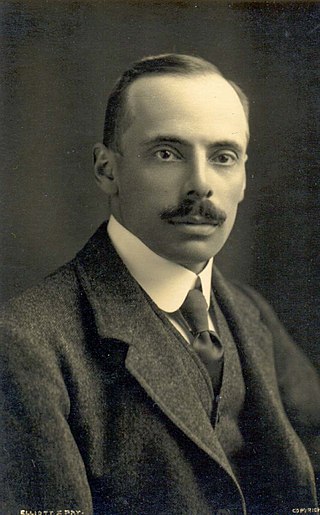Related Research Articles

An alphabet is a standardized set of basic written graphemes representing phonemes, units of sounds that distinguish words, of certain spoken languages. Not all writing systems represent language in this way; in a syllabary, each character represents a syllable, and logographic systems use characters to represent words, morphemes, or other semantic units.

Daniel Jones was a London-born British phonetician who studied under Paul Passy, professor of phonetics at the École des Hautes Études at the Sorbonne. He was head of the department of phonetics at University College London.
In phonology and linguistics, a phoneme is a unit of phone that can distinguish one word from another in a particular language.

The (International) Radiotelephony Spelling Alphabet, commonly known as the NATO phonetic alphabet, is the most widely used set of clear code words for communicating the letters of the Roman alphabet. Technically a radiotelephonic spelling alphabet, it goes by various names, including NATO spelling alphabet, ICAO phonetic alphabet and ICAO spelling alphabet. The ITU phonetic alphabet and figure code is a rarely used variant that differs in the code words for digits.

In a written language, a logogram, logograph, or lexigraph is a written character that represents a word or morpheme. Chinese characters are generally logograms, as are many hieroglyphic and cuneiform characters. The use of logograms in writing is called logography, and a writing system that is based on logograms is called a logography or logographic system. All known logographies have some phonetic component, generally based on the rebus principle.

Romanization or romanisation, in linguistics, is the conversion of text from a different writing system to the Roman (Latin) script, or a system for doing so. Methods of romanization include transliteration, for representing written text, and transcription, for representing the spoken word, and combinations of both. Transcription methods can be subdivided into phonemic transcription, which records the phonemes or units of semantic meaning in speech, and more strict phonetic transcription, which records speech sounds with precision.
Finnish orthography is based on the Latin script, and uses an alphabet derived from the Swedish alphabet, officially comprising twenty-nine letters but also including two additional letters found in some loanwords. The Finnish orthography strives to represent all morphemes phonologically and, roughly speaking, the sound value of each letter tends to correspond with its value in the International Phonetic Alphabet (IPA) – although some discrepancies do exist.
Phonetic transcription is the visual representation of speech sounds by means of symbols. The most common type of phonetic transcription uses a phonetic alphabet, such as the International Phonetic Alphabet.

The Yakama are a Native American tribe with nearly 10,851 members, based primarily in eastern Washington state.
A phonemic orthography is an orthography in which the graphemes correspond to the phonemes of the language. Natural languages rarely have perfectly phonemic orthographies; a high degree of grapheme–phoneme correspondence can be expected in orthographies based on alphabetic writing systems, but they differ in how complete this correspondence is. English orthography, for example, is alphabetic but highly nonphonemic; it was once mostly phonemic during the Middle English stage, when the modern spellings originated, but spoken English changed rapidly while the orthography was much more stable, resulting in the modern nonphonemic situation. On the contrary the Albanian, Serbian/Croatian/Bosnian/Montenegrin, Romanian, Italian, Turkish, Spanish, Finnish, Czech, Latvian, Esperanto, Korean and Swahili orthographic systems come much closer to being consistent phonemic representations.
Sahaptian is a two-language branch of the Plateau Penutian family spoken by Native American peoples in the Columbia Plateau region of Washington, Oregon, and Idaho in the northwestern United States.

The Umatilla are a Sahaptin-speaking Native American tribe who traditionally inhabited the Columbia Plateau region of the northwestern United States, along the Umatilla and Columbia rivers.
Americanist phonetic notation, also known as the North American Phonetic Alphabet (NAPA), the Americanist Phonetic Alphabet or the American Phonetic Alphabet (APA), is a system of phonetic notation originally developed by European and American anthropologists and language scientists for the phonetic and phonemic transcription of indigenous languages of the Americas and for languages of Europe. It is still commonly used by linguists working on, among others, Slavic, Uralic, Semitic languages and for the languages of the Caucasus, of India, and of much of Africa; however, Uralists commonly use a variant known as the Uralic Phonetic Alphabet.
A pronunciation respelling for English is a notation used to convey the pronunciation of words in the English language, which do not have a phonemic orthography.
Sahaptin or Shahaptin, endonym Ichishkin, is one of the two-language Sahaptian branch of the Plateau Penutian family spoken in a section of the northwestern plateau along the Columbia River and its tributaries in southern Washington, northern Oregon, and southwestern Idaho, in the United States; the other language is Nez Perce or Niimi'ipuutímt.
Romanisation of Bengali is the representation of written Bengali language in the Latin script. Various romanisation systems for Bengali are used, most of which do not perfectly represent Bengali pronunciation. While different standards for romanisation have been proposed for Bengali, none has been adopted with the same degree of uniformity as Japanese or Sanskrit.
Icelandic orthography is the way in which Icelandic words are spelled and how their spelling corresponds with their pronunciation.
Umatilla is a variety of Southern Sahaptin, part of the Sahaptian subfamily of the Plateau Penutian group. It was spoken during late aboriginal times along the Columbia River and is therefore also called Columbia River Sahaptin. It is currently spoken as a first language by a few dozen elders and some adults in the Umatilla Reservation in Oregon. Some sources say that Umatilla is derived from imatilám-hlama: hlama means 'those living at' or 'people of' and there is an ongoing debate about the meaning of imatilám, but it is said to be an island in the Columbia River. B. Rigsby and N. Rude mention the village of ímatalam that was situated at the mouth of the Umatilla River and where the language was spoken.
SaypYu is an approximative phonetic alphabet of 24 alphabet letters to spell languages, including English. The spelling system was adopted by Jaber George Jabbour to write English more phonetically. The 24-letter alphabet includes 23 Roman alphabet letters and the addition of a 24th letter, the IPA letter "ɘ" to play the role of schwa. The letter represents the initial sound of "ago" or "about".
Virginia Beavert is a Native American linguist of the Ichishkíin language at the University of Oregon.
References
- 1 2 Jansen, Joana Worth (June 2010). A grammar of Yakima Ichishkiin/Sahaptin (PhD thesis). University of Oregon.
- ↑ Jansen, J.W. (2020) Manuscript.
- ↑ Hargus, S. & Beavert, V. (2014) Northwest Sahaptin. Journal of the International Phonetic Association 44 (3), 311-342.
- ↑ Rigsby, B. & Rude, N. (1996) Sketch of Sahaptin, a Sahaptian language. In Goddard, Ives (ed.), Languages (Handbook of North American Indians 17), 666–692. Washington, D.C.: Smithsonian Institution.
- ↑ "Umatilla Language Online Dictionary". Confederated Tribes of the Umatilla Indian Reservation. Retrieved 2021-05-22.